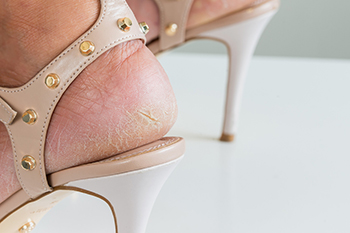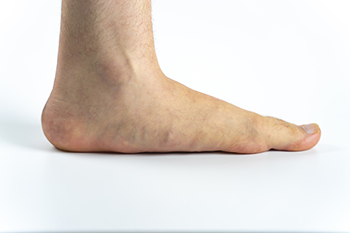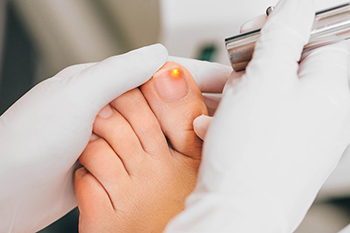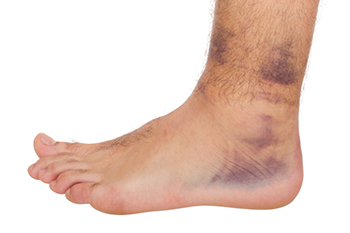Items filtered by date: October 2023
Seeing a Podiatrist for Cracked Heels

An individual would see a podiatrist for cracked heels because they are specialists in foot and ankle care, and cracked heels can be more than just a cosmetic issue. While minor heel fissures may be seen as a nuisance, severe cracks can be painful, bleed, or become infected. A podiatrist can identify the underlying causes of cracked heels, which may include biomechanical issues, skin conditions, systemic diseases, or prolonged pressure. This foot doctor can provide professional treatments such as debridement, where the hard, dead skin is removed safely, and prescribe specialized moisturizers or medicated creams. Additionally, they can offer guidance on footwear choices, recommend orthotic inserts to redistribute pressure, and offer advice on preventive measures. If you have persistent or severe cracked heels, it is suggested that you make an appointment with a podiatrist to ensure they are cared for and to avoid complications.
If the skin on your feet starts to crack, you may want to see a podiatrist to find treatment. If you have any concerns, contact one of our podiatrists from Sayville Foot Care. Our doctors can provide the care you need to keep you pain-free and on your feet.
Cracked Heels
It is important to moisturize your cracked heels in order to prevent pain, bleeding, and infection. The reason cracked heels form is because the skin on the foot is too dry to support the immense pressure placed on them. When the foot expands, the dry skin on the foot begins to split.
Ways to Help Heal Them
- Invest in a good foot cream
- Try Using Petroleum Jelly
- Ease up on Soaps
- Drink Plenty of Water
Ways to Prevent Cracked Heels
- Moisturize After Showering
- Skip a Shower
- Keep Shower Water Lukewarm
- Don’t Scrub Your Feet
If you are unsure how to proceed in treating cracked heels, seek guidance from a podiatrist. Your doctor will help you with any questions or information you may need.
If you have any questions, please feel free to contact our office located in Sayville, NY . We offer the newest diagnostic and treatment technologies for all your foot care needs.
Causes, Symptoms, and Treatment of Flat Feet

Flat feet, medically known as pes planus, is a common condition where the arch of the foot is abnormally low or nonexistent, causing the entire sole to touch the ground when standing. This can be due to various factors, such as genetics, obesity, pregnancy, or repetitive high-impact activities. While some people with flat feet experience no discomfort, others may develop symptoms that affect their daily lives. Flat feet can originate in childhood, where the arch has not yet developed, and may persist into adulthood. Over time, the wear and tear on the posterior tibial tendon can lead to the arch collapsing, resulting in overpronation. Ankles and knees can also be affected, as flat feet may cause the ankles to turn inward, leading to alignment issues in the legs. Symptoms can range from difficulty standing on tiptoe to knee and back pain, arch strain, and swelling along the inside of the ankle. When it comes to treatment, a range of options can help alleviate the discomfort associated with flat feet. Special shoes with strong heel counters, steel or carbon fiber shanks, and medial postings can assist in alignment. Custom-designed arch supports, molded to your foot's unique contours, are often recommended. Stretching exercises for a shortened Achilles tendon may also prove beneficial. For help in dealing with flat feet, it is suggested that you make an appointment with a podiatrist to determine the best course of action for your specific needs.
Flatfoot is a condition many people suffer from. If you have flat feet, contact one of our podiatrists from Sayville Foot Care. Our doctors will treat your foot and ankle needs.
What Are Flat Feet?
Flatfoot is a condition in which the arch of the foot is depressed and the sole of the foot is almost completely in contact with the ground. About 20-30% of the population generally has flat feet because their arches never formed during growth.
Conditions & Problems:
Having flat feet makes it difficult to run or walk because of the stress placed on the ankles.
Alignment – The general alignment of your legs can be disrupted, because the ankles move inward which can cause major discomfort.
Knees – If you have complications with your knees, flat feet can be a contributor to arthritis in that area.
Symptoms
- Pain around the heel or arch area
- Trouble standing on the tip toe
- Swelling around the inside of the ankle
- Flat look to one or both feet
- Having your shoes feel uneven when worn
Treatment
If you are experiencing pain and stress on the foot you may weaken the posterior tibial tendon, which runs around the inside of the ankle.
If you have any questions please feel free to contact our office located in Sayville, NY . We offer the newest diagnostic and treatment technologies for all your foot and ankle needs.
Arthritis Can Cause Pain in the Feet and Ankles
Laser Therapy and Toenail Fungus

Toenail fungus, or onychomycosis, can be stubborn and challenging to treat with traditional methods. However, recent advancements in medical technology have introduced an effective alternative, which is known as laser therapy. This innovative approach utilizes concentrated beams of light to target and eliminate the fungus residing beneath the toenail. The laser treatment process begins with the application of the laser, which penetrates the nail. This specifically targets the fungal infection while leaving the surrounding healthy tissue unharmed. The laser generates heat, effectively eradicating the fungal cells and inhibiting their ability to regrow. Laser treatment offers several advantages. It is non-invasive, requires no anesthesia, and typically involves minimal discomfort. Additionally, it can be extremely effective, often requiring fewer sessions than traditional treatments. Patients can generally resume their daily activities immediately following the procedure. As with any medical treatment, consultation with a podiatrist is crucial in determining what the best approach is for your specific condition. Laser therapy represents a promising option in the battle against stubborn toenail fungus, offering a safe, efficient, and minimally disruptive solution to restore healthy and clear nails. If you are afflicted with toenail fungus, it is suggested that you seek the counsel of a podiatrist who can determine if laser treatment is right for you.
Laser treatment can be an effective way to get rid of toenail fungus. If you have any questions about laser treatment, consult with one of our podiatrists from Sayville Foot Care. Our doctors will assess your condition and provide you with quality treatment for fungal nails.
What Are Toenail Fungal Infections?
Onychomycosis, or fungal infection of the nail, is a relatively common and non-serious condition. Around 10 percent of U.S. citizens are afflicted with fungal nails. Common forms of fungus that infect the nail include dermatophytes, yeasts, and molds.
Symptoms of Toenail Fungal Infections Include:
- Nail thickening
- Brittleness of the nail
- Discoloration of the nail
Diagnosis for Fungal Nails
Fungal infections are diagnosed by fungal culture and microscopy. This will rule out any other conditions such as nail trauma, psoriasis, lichen planus, and onychogryphosis.
What Is Laser Treatment?
Laser treatment is a non-invasive, safe, quick, and painless procedure that uses the heat from a laser to kill fungus in the nail. Each infected nail is targeted with a laser for several minutes. The treatment is usually utilized several different times over a select period. During this time, a podiatrist will keep an eye on the infection.
If you have any questions, please feel free to contact our office located in Sayville, NY . We offer the newest diagnostic and treatment technologies for all your foot care needs.
Chronic Ankle Instability

Ankle sprains happen again and again, and about one in five cases that start as short-term issues become long-term problems affecting the ankle. These long-term problems often occur because the initial sprain was not properly treated. Getting the correct diagnosis is very important. Special tests such as the varus stress test and the anterior drawer test can help doctors determine what the cause is. Occasionally, doctors may miss another issue called subtalar instability, which can also cause long-term ankle problems. Most of the time, simple treatments work for short-term sprains, but for long-term issues, surgery may be needed. Knowing the structure of the ankle and how it works may help to improve surgery and other treatments. Surgeries often repair the natural structure of the ankle and may use tendons to make it stronger. A type of surgery called arthroscopy is becoming popular for treating long-term ankle problems because it is less invasive. If you have ongoing ankle issues, it is suggested that you make an appointment with a podiatrist who can accurately diagnose and offer the correct treatment for you.
Although ankle sprains are common, they aren’t always minor injuries. If you need your ankle injury looked at, contact one of our podiatrists from Sayville Foot Care. Our doctors can provide the care you need to keep you pain-free and on your feet.
How Does an Ankle Sprain Occur?
Ankle sprains are the result of a tear in the ligaments within the ankle. These injuries may happen when you make a rapid shifting movement while your foot is planted. A less common way to sprain your ankle is when your ankle rolls inward while your foot turns outward.
What Are the Symptoms?
- Pain at the sight of the tear
- Bruising/Swelling
- Ankle area is tender to touch
- In severe cases, may hear/feel something tear
- Skin discoloration
Preventing a Sprain
- Wearing appropriate shoes for the occasion
- Stretching before exercises and sports
- Knowing your limits
Treatment of a Sprain
In many cases, the RICE method (Rest, Ice, Compression, and Elevate) is used to treat ankle sprains. However, you should see a podiatrist to see which treatment option would work best with your injury. In severe cases, surgery may be required.
It is important to ask your doctor about rehab options after you receive treatment for your injury. Stretching, strength training, and balance exercises may help the ankle heal while also preventing further injury.
If you have any questions, please feel free to contact our office located in Sayville, NY . We offer the newest diagnostic and treatment technologies for all your foot care needs.
Foot Pain and Pregnancy

Pregnancy is usually an event that is looked forward to with anticipation and excitement. However, it is also a time where many changes take place in a woman’s body and some of them are challenging. For example, pregnancy can lead to changes in foot anatomy, potentially increasing the risk of foot pain and musculoskeletal issues. It has been found that orthotics can help to prevent back pain and arch collapse during pregnancy. Orthotics are designed to absorb shock, increase stability, and reduce extra movement that can aggravate pain. These, along with wearing supportive, well-fitting shoes, can provide relief. If you are pregnant and enduring foot or related pain, it is suggested that you make an appointment with a podiatrist who can help you to find ways to get through these common discomforts more comfortably.
Pregnant women with swollen feet can be treated with a variety of different methods that are readily available. For more information about other cures for swollen feet during pregnancy, consult with one of our podiatrists from Sayville Foot Care. Our doctors will attend to all of your foot and ankle needs.
What Foot Problems Can Arise During Pregnancy?
One problem that can occur is overpronation, which occurs when the arch of the foot flattens and tends to roll inward. This can cause pain and discomfort in your heels while you’re walking or even just standing up, trying to support your baby.
Another problem is edema, or swelling in the extremities. This often affects the feet during pregnancy but tends to occur in the later stages.
How Can I Keep My Feet Healthy During Pregnancy?
- Wearing orthotics can provide extra support for the feet and help distribute weight evenly
- Minimize the amount of time spent walking barefoot
- Wear shoes with good arch support
- Wear shoes that allow for good circulation to the feet
- Elevate feet if you experience swelling
- Massage your feet
- Get regular, light exercise, such as walking, to promote blood circulation to the feet
If you have any questions please feel free to contact our office located in Sayville, NY . We offer the newest diagnostic and treatment technologies for all your foot and ankle needs.

